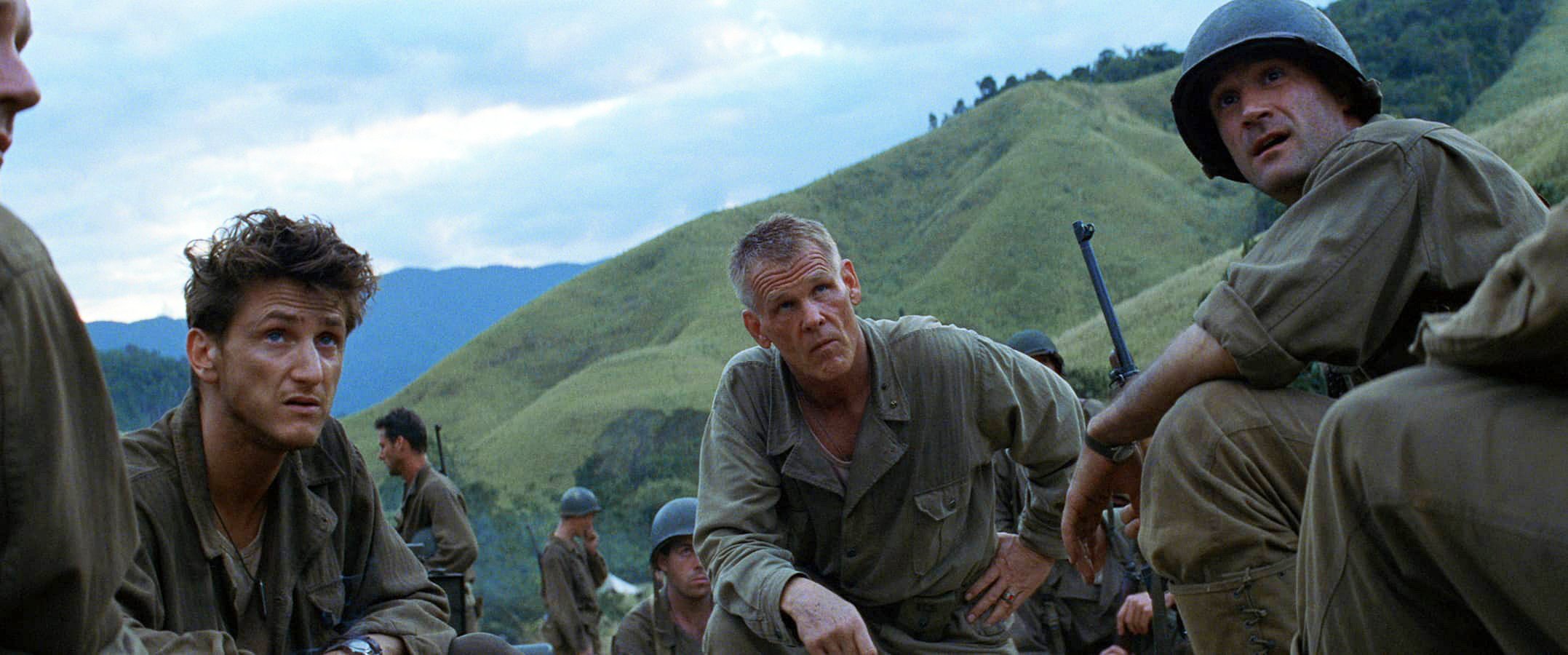
The Thin Red Line: The War Within
John Toll, ASC details his experiences on this existential combat film that marks the long-awaited return of director Terrence Malick.
Unit photography by Merle W. Wallace
The Battle of Guadalcanal was one of World War II’s pivotal conflicts. Early in 1942, Japanese forces in the South Pacific were advancing toward the Solomon Islands, which had been selected as the strategic site of an airfield that would extend the range of the Axis power’s air force. When U.S. intelligence relayed this information back to Washington, America’s military brain trust decided that the airfield, which would threaten Australian sea lanes, had to be controlled — at any cost. Mobilizing much more quickly than the Japanese had anticipated, the U.S. sent in the First Marine Division, which quickly took over the lightly defended airfield at Guadalcanal’s Lunga Point. The Japanese soon mounted a counter-offensive that led to six months of brutal combat, during which the Marines managed to repel wave after wave of seasoned troops. After a gradual buildup of forces by both sides, the Americans finally hammered out a decisive victory.
The Thin Red Line is the story of a rifle company within the Army’s 25th Division, which arrived on Guadalcanal in November of 1942 to reinforce the Marines. At that point in the battle, the thousands of Japanese troops who were still on the island had adopted defensive tactics, retreating into the territory’s grassy hills. There, they would face torturous attrition exacted by malaria, starvation and the Americans, who were ordered to flush them out.

This historical event served as the backdrop of James Jones’s 1962 novel, a semi-autobiographical work which offers some searing insights into the human condition. Director Terrence Malick (Badlands, Days of Heaven), who hadn’t helmed a motion picture since 1978, made the book the basis of his screenplay, which generated a loud buzz in Hollywood. Malick’s long-awaited return to active duty lured in some of the industry’s biggest stars, including John Cusack, George Clooney, Woody Harrelson, Nick Nolte, Sean Penn and John Travolta, as well as such capable but lesser-known actors as Adrien Brody, Jim Caviezel, Ben Chaplin, Elias Koteas, Jared Leto and John C. Reilly.
In selecting a director of photography for his haunting, elegiacal war drama, Malick chose two-time Academy Award-winning director of photography John Toll, ASC (Legends of the Fall, Braveheart), whose work on The Thin Red Line recently earned him both the New York Film Critics’ and National Society of Film Critics’ awards for Best Cinematography. Toll recently spoke with AC about working with the reclusive director and supervising the lengthy and often arduous location shoot.
“The idea of this particular project was really interesting to me, and not just because it was a war movie.”
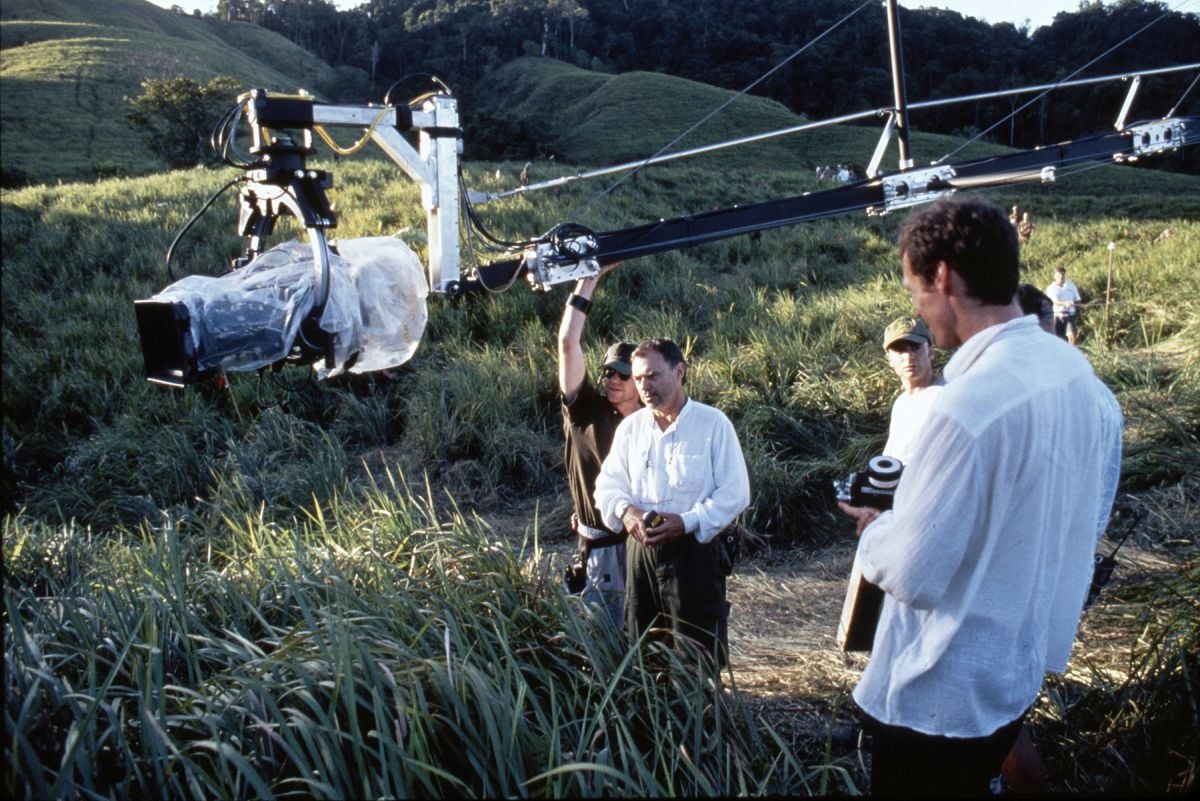
American Cinematographer: How did you land the assignment to photograph The Thin Red Line?
John Toll, ASC: I knew one of the producers, Grant Hill. He’s from Australia, and he worked on the first picture I shot, Wind, which was filmed there. After that project, he came over to the States, where he’s been [a unit production manager] on films like Titanic and The Ghost and the Darkness. He’d been working with Terrence Malick on The Thin Red Line for about six months, and he called me when they began looking at directors of photography. Terry had already talked to several cinematographers when I finally got on the phone with him, but we just happened to hit it off.
Was that call your first encounter with Malick?
Yes, I didn’t know anything about his personality. I’d seen Badlands and Days of Heaven, of course, and they’re both great pictures. Whenever you see films like those, you always think, ‘Well, it would be great to work with a director like that, because he’s obviously interested in making films, as opposed to just commercial product.’ Back when Terry made those pictures, there wasn’t such a clear line between commercial pictures and ‘thinking’ pictures; nowadays, there’s a real distinction between those types of films. I understand that the film industry is a business, but we don’t all want to go through our careers just making commercial projects. The idea of making the type of picture that Terry seemed to be going for with The Thin Red Line was obviously desirable. I’m sure that the other cinematographers he spoke to were just as enthusiastic about working with him as I was, but I just happened to get lucky.
“The characters in this story are very well-drawn and diverse. Some are heroes, some aren’t, and some are just there to do their job and get out as quickly as possible.”

When did you finally meet Malick in person? What were your first impressions of him?
I was actually working in Tennessee, and I had to come back to L.A. one weekend. Terry was living in Austin, Texas, so I stopped off there and we spent a day talking about the project. I didn’t know what to expect, but I found him to be very low-key, personable, and unpretentious. He’s a straightforward person, and he was extremely collaborative right from the start. It was always, ‘Well, what do you think? Here’s what I’m thinking.’ He never said anything like, ‘Okay, we’re going to do this and this and this.’ His approach is a bit more nonlinear. He doesn’t have a precisely defined vision of things from the very beginning, but he’s intuitive and knows where he wants to go with the material. The specifics are things that he finds along the way. He feels the direction, can see it out there, and knows that as he moves toward it things will become more clearly defined. He attempts to plot every stage of the trip before you begin, and then sort of fine-tunes his approach on the journey. It’s a process of discovery, and he feels that it’s a bit pointless to define the parameters any further until you’re closer to your objective.
Did your director’s 20-year absence from the industry have any effect on the production?
Not really. One of the great things about this project was that several key members of the filmmaking team [production designer Jack Fisk, assistant director Skip Cosper, casting director Dianne Crittenden and editor Billy Weber] had worked with Terry on his previous films. So even though it had been two decades since Terry had made a picture, he came back into this core unit. They just sort of picked up where they’d left off, and we didn’t really feel that 20-year gap. Of course, there was 20 years of technology that he wasn’t particularly familiar with [laughs], but he’s a great filmmaker and he picked up those types of things very quickly and intuitively.
“It was always, ‘Well, what do you think? Here’s what I’m thinking.’ He never said anything like, ‘Okay, we’re going to do this and this and this.’”
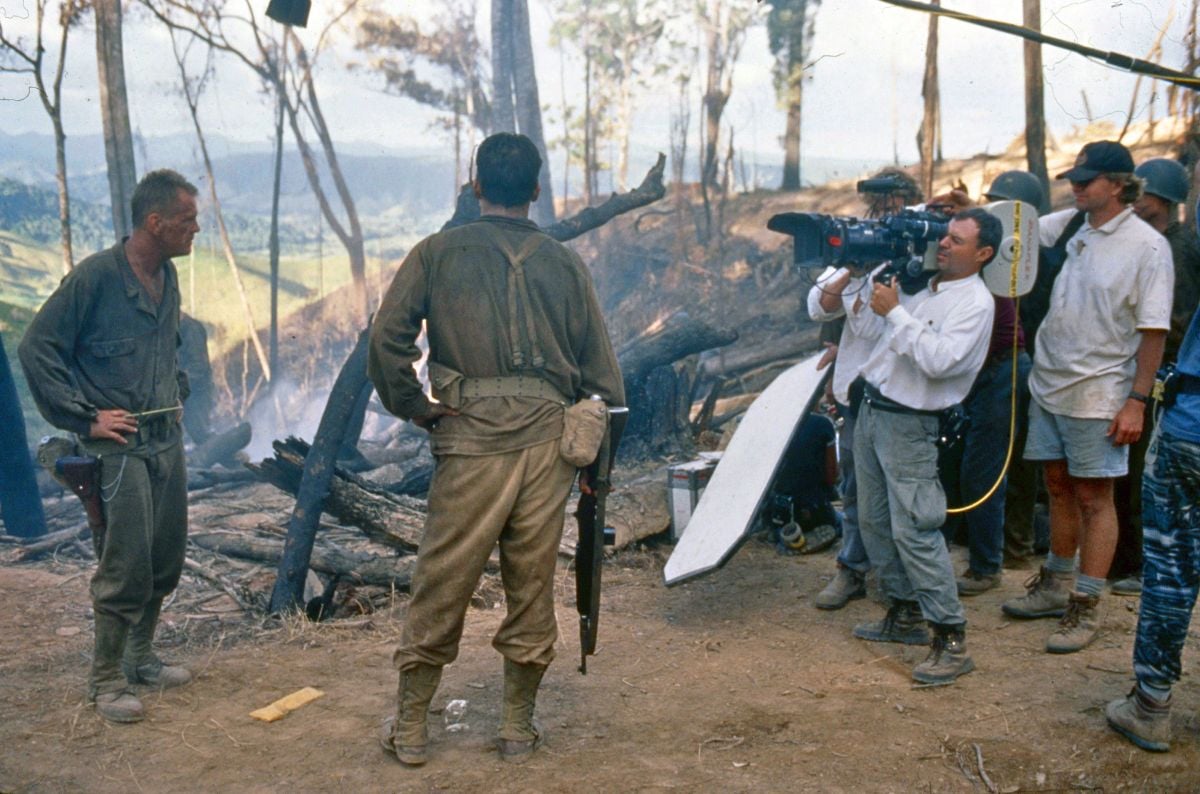
Were you immediately drawn to the script?
The idea of this particular project was really interesting to me, and not just because it was a war movie. I remembered reading the James Jones novel when it first came out, and finding it to be just fantastic. I wasn’t in the film industry at the time, but I recall thinking that it would make a great motion picture. A film adaptation was actually made in 1964, but it was a pretty low-budget version, and I was a bit disappointed with it.
The book is an incredibly realistic depiction of the experience of combat. Jones was a member of the Army’s 25th Division; he was at Schofield Barracks in Hawaii during the attack on Pearl Harbor, and he also participated in the Battle of Guadalcanal, so From Here to Eternity and The Thin Red Line are both based on his firsthand experiences. The most interesting thing about The Thin Red Line is the way it gets into all of these soldiers’ different personalities. While we were shooting the picture, Terry and I kept talking about how interior the narrative was; there’s an enormous amount of material in the book about what the characters are experiencing internally — as opposed to what comes out in their conversations, which usually represents an entirely different aspect of their personalities. Terry wanted the viewers to know what was happening within the minds of the characters without necessarily presenting those thoughts through dialogue.
The characters in this story are very well-drawn and diverse. Some are heroes, some aren’t, and some are just there to do their job and get out as quickly as possible. It’s really a story about the tragedy of war. I got very caught up in the book when I read it, particularly the realistic aspects of being involved in that kind of experience. It was a very truthful story that presented all of the good stuff and all of the bad stuff. You just knew that Jones had been there.
“One of the things that struck us immediately during the Guadalcanal scout was how loaded with color this tropical environment was; after all, we’re used to seeing black-and-white newsreels of World War II combat.”
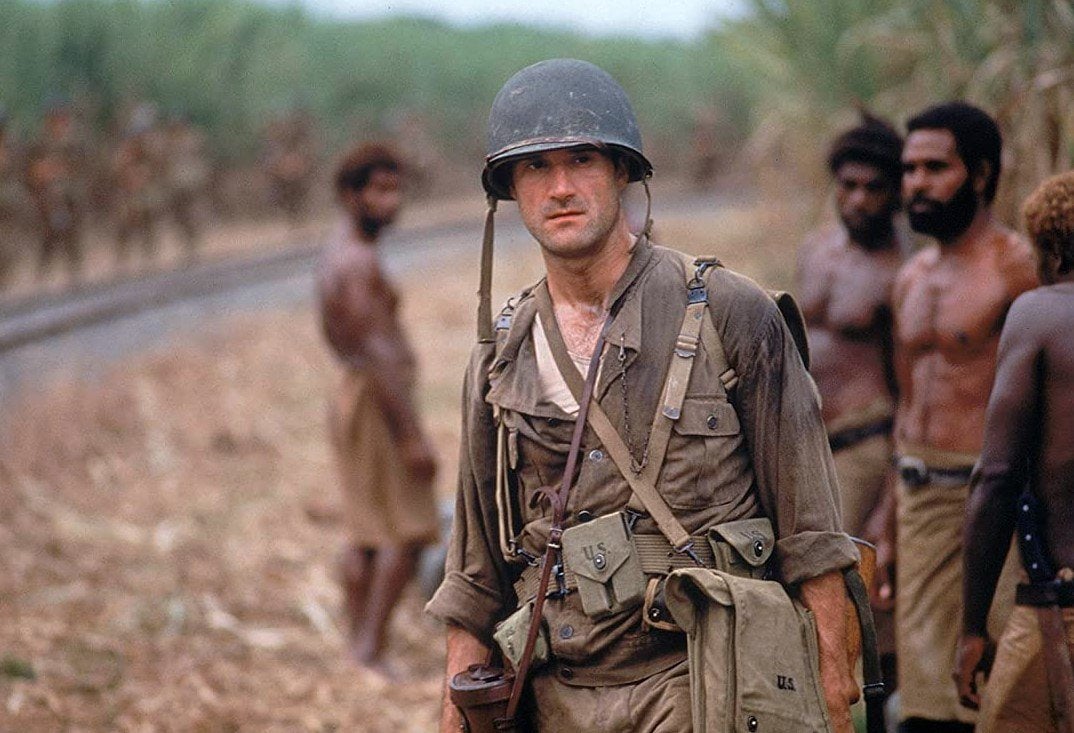
From what you’wsve said about Malick’s personality, I’m assuming he isn’t big on storyboards.
Actually, we did storyboard a few sections of the film. At the beginning of the picture, the troops are on a transport ship on the way to Guadalcanal, and there’s a big landing sequence. We storyboarded that because we didn’t have the resources to have the numbers of real ships and transports that we needed; we had to do some CGI, so we used the sketches to simplify our lives. Whenever you have a sequence on the water, you can immediately get into trouble if you’re not prepared.
What other kinds of prep work did you do?
There were a lot of conversations, and we also scouted in Guadalcanal, which was an unbelievable experience. The place has changed, but not a whole lot. It’s a beautiful island, but it’s extremely tropical and not very developed because the region has one of the highest malaria rates in the world. During the war, enormous numbers of people came down with malaria; it was worse for the Japanese because they weren’t well-supplied. That was one of the biggest drawbacks in their battle plan, and many of those crack troops wound up just starving to death. It was basically a win-or-die situation because the Japanese simply would not surrender.
One of the things that struck us immediately during the Guadalcanal scout was how loaded with color this tropical environment was; after all, we’re used to seeing black-and-white newsreels of World War II combat. At one point, we did talk about shooting the picture in black-and-white, but that notion didn’t really take hold. The idea of all of this violence taking place in such a rich and colorful environment was very striking, and we felt that representing the story any other way just wouldn’t be accurate. We got a lot of ideas about tones and colors as we explored the area.
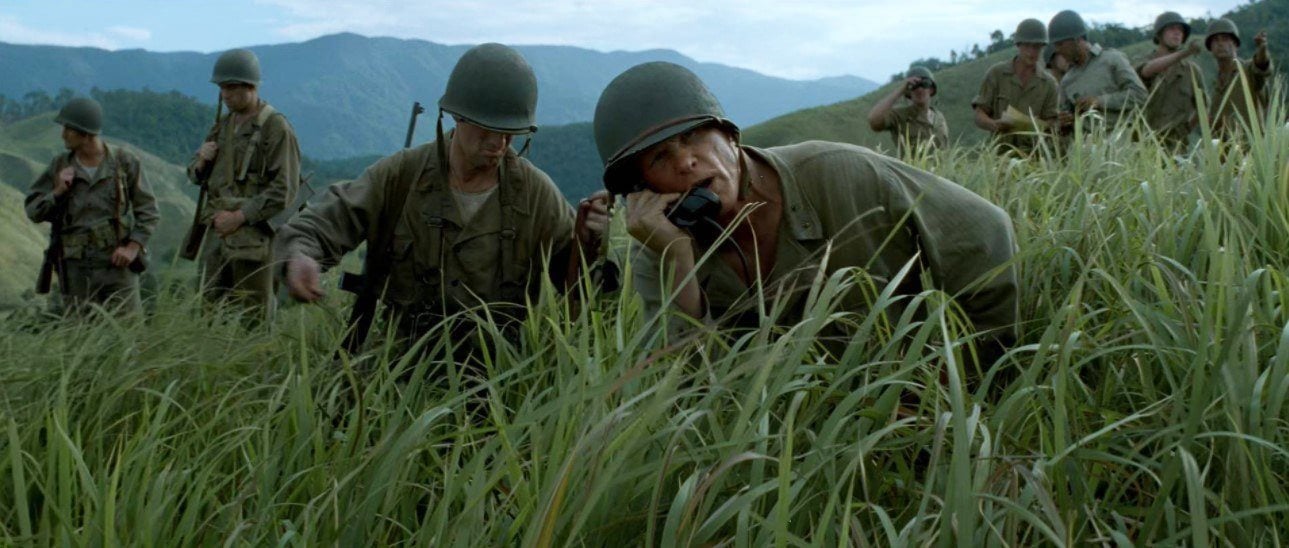
Eventually, you opted to shoot most of the film in Australia. What led to that decision?
We didn’t want to work in Guadalcanal for all of the same reasons that you wouldn’t want to go there during a war. There’s still a 50 percent rate of malaria, and it just wasn’t feasible logistically if we wanted to have the kind of technical support we knew we’d need. It’s still a bit difficult to get on and off the island, and we had some scenes that involved 200 or 300 extras. We would have had to bring everybody to Guadalcanal, and financially it just didn’t make sense.
The real battlefields depicted in the book basically consist of grassy hills, and we began looking all over the world for that type of terrain. When we went to Australia, which is just 1,000 miles from the Solomon Islands, we found the same types of terrain — beaches, beautiful coral reefs, and grassy hills on the north coast near Queensland. Australia also has some great crews and resources, and a good lab, Atlab, right there in Sydney. It made an enormous amount of sense to shoot there. I still knew a lot of people from my experience on Wind, such as gaffer Mick Morris and key grip David Nichols, and many of them were hired for this picture.
In the end, we wound up shooting for 80 days in Australia and another 20 in Guadalcanal.
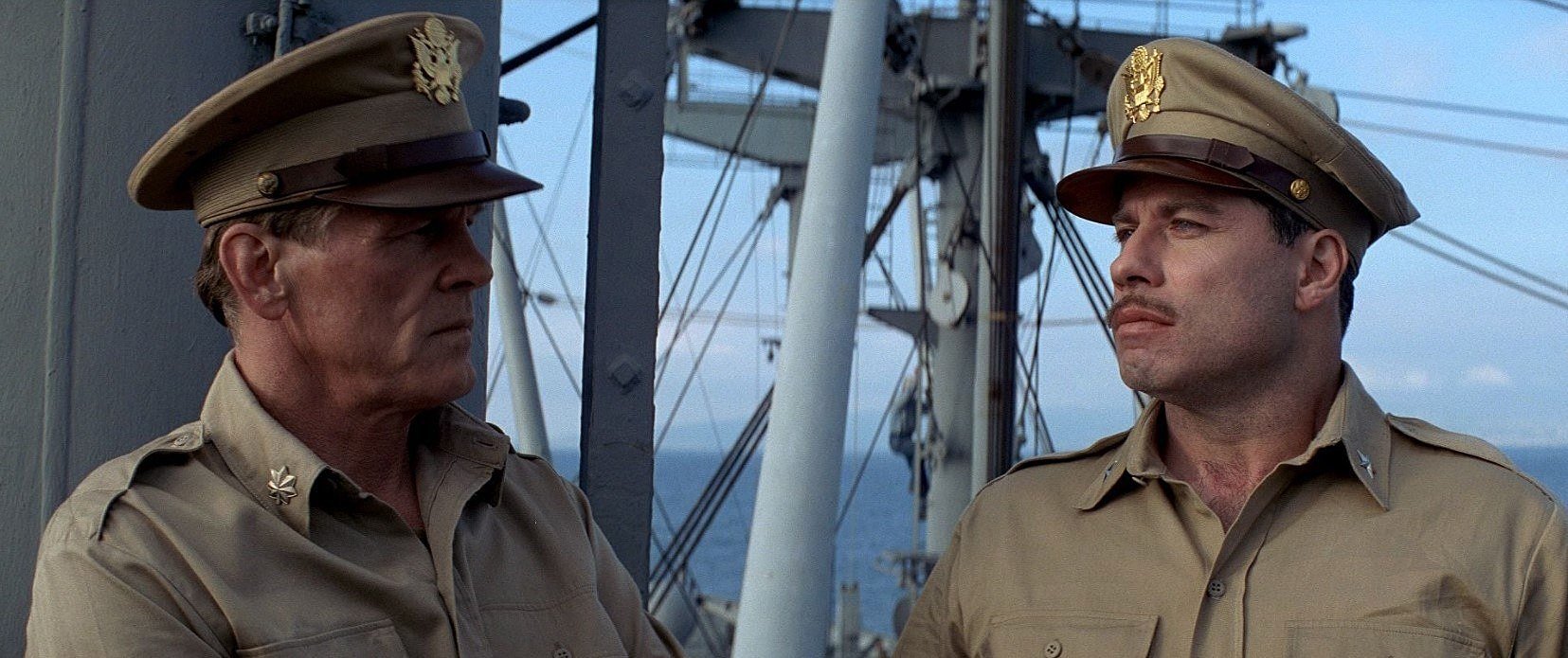
Did you have any specific visual inspirations for the look of the film?
During the shoot, Jack Fisk brought us this book called Images of War: The Artist’s Vision of World War II [1992, edited by Ken McCormick and Hamilton Darby Perry], which presents 200 paintings by many different artists. These were artists who spent time in the front lines and came back with this fantastic artwork depicting the scenes they had witnessed, including many combat situations. All of the artists had different and unique styles. We didn’t necessarily try to reproduce these pieces of art, but they did give us good ideas about color schemes and so on. The illustrations basically served as a guide to the kind of atmosphere we were after.
We’d looked at many photographs from the war, but they seemed too detailed somehow, and I wanted the imagery of our film to be a bit less clearly defined. The paintings were great because they were much more impressionistic and abstract in a way that I found more interesting than the photographs. For example, there was one drawing of Japanese prisoners sitting on the ground, and the light they were drawn in — bright contrasty sunlight which left their faces in shadow — looked very similar to the light conditions we were shooting in. There was detail in the prisoners’ faces, but the highlights of the background were bright and burned-out. I thought it looked fantastic.
In some scenes [that I’d shot to that point], I had lit the actors’ faces or had used fill-in situations with heavy contrast, but I’d begun doing it less and less because I started to like the way the film looked when I didn’t use fill — overexposing quite a bit, getting detail in the shadows and letting the highlights burn out. It looked much less controlled in an interesting way. After seeing the drawing, which was a much more exaggerated version of what we’d been doing photographically, I went with less and less added light.
“Terry and I agreed that this film really needed to feel as realistic as possible. Naturally, there is a certain amount of visual stylization in the film, but we tried to lend the images an integrity so that viewers could believe that they were watching a real event.”

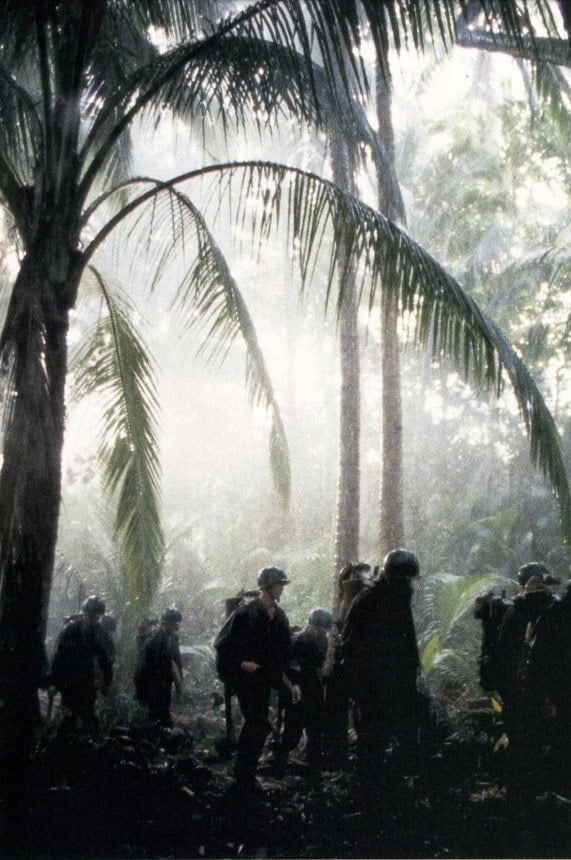
How did those ideas factor into your overall stylistic approach?
Terry has a basic honesty, which is part of the reason that we get along. We were trying to recreate this historical event in a way that was truthful. The film is not a documentary, but we wanted it to have the integrity of a great documentary. We didn’t necessarily want to shoot it like a documentary, but we tried to lend the story a natural kind of realism. We sought out to capture the book’s honest depiction of the various types of reactions to the combat experience — the full range of human emotions. War itself, and the infantryman’s experience of it, is probably as fundamental and basic as you can get in terms of the human condition and how people react to its extremes. It pushes people to their limits, and what emerges can be very surprising in both good and bad ways. Somehow, we had to weave that sense of honesty into the visual presentation. Terry and I agreed that this film really needed to feel as realistic as possible. Naturally, there is a certain amount of visual stylization in the film, but we tried to lend the images an integrity so that viewers could believe that they were watching a real event — without feeling as if they were being overly manipulated by a great filmmaker. I sometimes see great visual films that are obviously so well-stylized and well-controlled that I feel slightly overmanipulated; it might be fantastic, beautiful work, but in my mind, I don’t feel as if I’m watching reality.
Why did you choose to shoot in true anamorphic rather than Super 35?
We chose straight anamorphic over Super 35 because I don’t really like the idea of having an optical step at the end of the answer-print process. I want to know that what we’re seeing during dailies is definitely what we’re going to get in our original neg prints. Terry and I had always planned that this would be a widescreen picture because we wanted to see the characters within their environments; after all, that’s the major focus of the story.
What kind of camera package did you assemble for the shoot?
Everything came from Panavision in Los Angeles. We took a couple of lightweight Platinum camera bodies, one for the Steadicam and one for the handheld stuff. I still really like the Gold camera, so I used one of those as my primary sound and dolly camera. [Cinematographer] Gary Capo headed up our second unit, and he had a couple of Panastars and an Arri. In terms of the lenses, we used Primos as well as C-series lenses on the Steadicam. We also had 3:1 and 11:1 zooms, but we didn’t use them very much. It was pretty much a wide-angle movie, so we shot mainly with wider lenses, like the 40mm and 50mm. Our close-ups were mainly done with the 75mm or 100mm. We were constantly fighting to get as much of the geography into the frame as we could. Every time we put on a tighter lens it just felt as if we were missing something.
There’s quite a bit of camera movement in the picture. Were you trying to create a subjective point of view?
Right from the beginning, we talked a lot about making the viewers feel as if they were watching this story from close up, almost as if they were participants. A lot of what the characters go through emotionally is unspoken, so it was necessary to convey those moments in a visual way. We wanted the camera to tell the story and yet somehow be part of the story — almost as if the audience was making the same journey as the characters.
Terry and I talked extensively about creating a sense of movement throughout the whole picture. He loves to speak in metaphors, and he kept saying, ‘It’s like moving down a river, and the picture should have that same kind of flow.’
“We knew we wanted something more, so we decided to loosen up our approach a bit. As a result, there’s a lot of Steadicam and handheld work in the picture.”
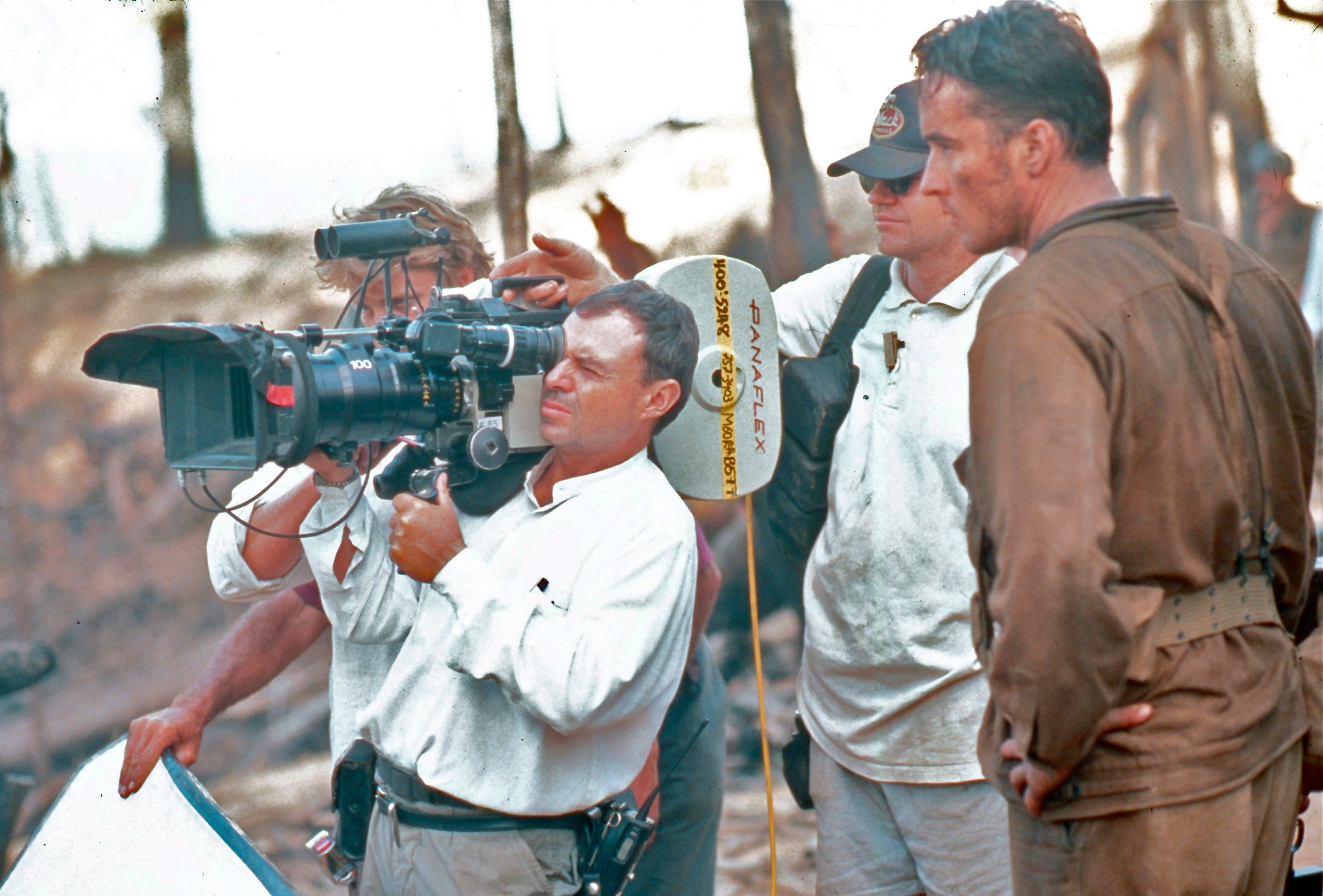
How did you achieve that sensation technically?
During prep, we had talked about various ways to create that kind of style, but we never settled on a single approach. On the first couple of days of the schedule, we shot some scenes with a moving camera on a dolly and some with stationary cameras incorporating conventional coverage and angles. It was all technically correct, and there was nothing wrong with the scenes, but when we viewed the footage, it sometimes felt very ‘staged’ and overly structured for the camera.
We knew we wanted something more, so we decided to loosen up our approach a bit. As a result, there’s a lot of Steadicam and handheld work in the picture. We had a great Australian Steadicam operator named Brad Shields. We allowed the camera to explore a bit, and Terry encouraged the actors to try something different if they felt like it. At times, the camera would drift from one actor to another; we might not get conventional masters or coverage, but it didn’t seem that important. Every scene became a unique situation, and we just shot what seemed to be most appropriate for a particular sequence. We allowed the camera to follow the emotional thread of a scene without worrying about much else. What seemed to emerge from that was a feeling of unpredictability which completely supported the idea that Guadalcanal was a strange and dangerous place that these characters suddenly found themselves in.
Terry got into that style of shooting immediately; he has a rather spontaneous and unpredictable personality, so the idea made a lot of sense to him. Using Steadicam and a handheld camera certainly isn’t a new idea, but the challenge was in shooting scenes that way without drawing unnecessary attention to the techniques themselves. I wanted to use the fluid, mobile camera movement as part of the overall style of the film, but in a way that supported the story.
Those techniques are very effective during a key sequence in which the Americans finally overtake the Japanese in a bivouac area.
That scene is basically the Japanese soldiers’ last stand. Some of them are dying of starvation, some commit suicide, some surrender and others decide to fight to the last man. I think we really captured the chaos and tragedy of that type of battle. No one really wants to be there, but they have to follow orders, and whether given individuals survive or get killed is really just a matter of chance. The whole sequence was done with either a handheld camera and/or the Steadicam — primarily the Steadicam — and Brad Shields did a great job on it. The Americans are running into the area and the Japanese are all around them, so you don’t know if the guy next to you is friend or foe. Once we set up for that scene, we had the actors go in and improvise action. We then kept repeating the sequence over and over, following different characters through this nightmarish situation. It was semi-controlled chaos, and it wasn’t over-rehearsed to the point where everyone always knew what they were going to do. There were many extras in the scene, a lot of people firing at each other, and various guys taking some predetermined hits. We just let the camerawork be as free-form as possible.
“One of our biggest challenges was a daytime battle sequence in these grassy hills. The Japanese were in the hills, and the Americans had to go up there, find them, and kill them.”
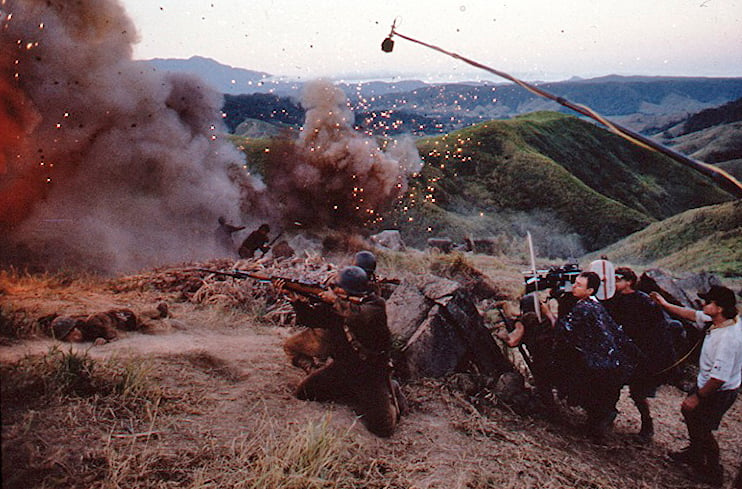

You also made extensive and interesting use of the Akela crane in the film.
The Akela was a great asset. One of our biggest challenges was a daytime battle sequence in these grassy hills. The Japanese were in the hills, and the Americans had to go up there, find them, and kill them. To deal with those scenes, we brought in the Akela, which came with two American technicians. The terrain was very uneven; the grass was about waist-high, and underneath it there were a lot of rocks and holes. We spent weeks climbing up and falling down these hills. At times we could use the Steadicam really well out there, but at other times it became impossible because we wanted to see the soldiers actually going up the hills. One of the tougher challenges we faced was preserving the look of this waist-high grass. You couldn’t walk through the grass more than a couple of times without leaving these huge paths. It was like working in snow, where you’ve got to cover your tracks. There’s only so much you can do before you destroy the look of the location.
I was contemplating this problem long before we got to the location because I knew what we were up against with the grass and the steep hills. I began thinking about using the Akela crane, which has an extremely long, 72’ arm that would allow us to get the camera into places where we couldn’t walk or lay dolly track. The only problem was that I wanted to install the crane on the sides of hills, which involved building some fairly substantial platforms because the Akela weighs about 6,000 pounds. It worked out fabulously, though. The Akela’s arm does have a slight arc, but it’s a much more minimal arc than any conventional crane arm. Because of that, we could make shots that had the appearance of a dolly shot. That was the whole reason for bringing in the Akela, and we constantly had it at very low angles; I don’t think we used it more than once or twice for a high-angled shot. Our expert technicians, Michael Gough and Mark Willard, kept wanting to show off how high it would go, but I kept hammering them with my mantra: ‘It’s a dolly, not a crane.’ We basically turned our crane technicians into dolly grips, but they did a fantastic job.
There are some great Akela crane shots in the film where we follow the soldiers over really long distances. We did have to train the actors to stay with the crane arm, because it doesn’t move in a perfectly straight line. If we were ahead of them, they could just follow the lens, but if we were shooting from behind, we would trace out the arc so the actors could follow it. But using the Akela really allowed us to get down in the grass and get shots that just wouldn’t have been possible with a dolly or even a Steadicam because of the uneven terrain.
What kind of remote head were you using on the Akela?
We attached a Libra 3 head, which worked out great for us. I’d used an earlier version of it, called the Megamount, on Braveheart. Nick Phillips, who’s based in London, designed both versions. I knew that the Libra 3 was a good remote head, and it has all of these stabilization characteristics that other remote heads don’t have, such as an electronic gyrostabilizer rather than a mechanical one. We were moving the crane arm really fast and coming to abrupt stops, and the Libra really helped to take any wobble out of the arm.
Part of the initial motivation for bringing in the Libra 3 was that I wanted to have a really stable camera for the shipboard scenes in the landing sequence. We put the Libracam and head on a crab dolly with a hydraulic arm that we could raise and lower. When we set that rig up on the deck of the smaller landing craft, it stabilized the horizon gyroscopically; we got these fantastic shots where the troops and the craft itself are in the foreground, and you really get a sense of the movement because the horizon is absolutely stable. It almost seems as if the camera’s not really on the landing craft because the boat is moving up and down all around it. You really get a sense of the sea motion.
Later on in the picture, we put the Libra head in the back of a truck that was transporting some of the characters through the airfield. The road was so bouncy that you couldn’t even look through the camera, but the Libra 3 completely smoothed it all out.
There’s a particularly interesting flashback shot of one of the American soldiers’ wives on a swing. How did you get such an unusual perspective?
We didn’t even use a head for that shot. The camera was actually upside-down; I think it was Terry’s idea. Once we put the actress on the swing, I wanted to get the camera at her eye level, so we just put the camera on top of a ladder behind her. When she swung back, she was heading right toward the camera, which was just off to the side of her; it was about two feet from the actress’s face when she got to the top of her arc. We initially tried the shot with the camera right-side up, but when we flipped the camera over and did it again it looked great.
In addition to the Australian hills, you also had to deal with a jungle. How did that affect your lighting strategy?
In those situations, scouting is everything. We would basically clear out a path to get the gear in, and then take the actors in another 100' and let them struggle. [Laughs.]
We did haul some lights into the jungle, but when we turned them on, they completely changed the character and nuances of the natural light. It was beautiful in there, but we were dealing with extremely low light levels. There were subtleties in the colors and gradations of the natural light that completely disappeared when we mixed in any artificial fill. There was plenty of contrast, though, because the sunlight that did filter in created great hot highlights. I decided to just expose into the shadows as much as possible and go for the natural falloff of the shadows to compensate for lack of detail. It worked out okay.
This became a general approach to lighting most of the exteriors. I started out using some amounts of fill, but I became less and less interested in controlling contrast; I would expose for the shadow detail that I wanted and then usually let highlights go. At times, we would use indirect light bounced from muslin or beadboard to lift faces, and maybe use black for negative, but when we were working in heavy contrast, I was quite a bit overexposed from what a more normal exposure would be in those situations. When it was sunny, it was extremely contrasty, but rather than trying to balance everything by adding fill, I just ignored the highlights.
I thought the film actually started looking much better when we lost the details in the highlights; it seemed more appropriate for the story. The more contrasty things got, the better, because it felt as if things were out of control — just as they were in the story.
Can you give me an example of how the lighting conditions affected your work with the actors?
There’s a sequence that I like between Nick Nolte, who plays this mad colonel, and John Cusack, who’s his adjutant. In the scene, which occurs about halfway through the battle, Nolte tells Cusack not to worry about the men and to focus on the charge up the hill. We were on top of a hill in an area with all of these burned-out tree trunks. It was extremely contrasty, but we really wanted to get into the faces and show the actors’ expressions. We chose to shoot in a direction that would allow us to take advantage of the light. We put them in areas where they were in direct sunlight that was broken up by the trees, and we also added smoke to soften the sunlight. We wanted to show the environment, but we also chose angles that were good for close-ups and dialogue. We used some white fill and black negative to give the characters some shape and contrast, but choosing the right angles was the most important consideration.
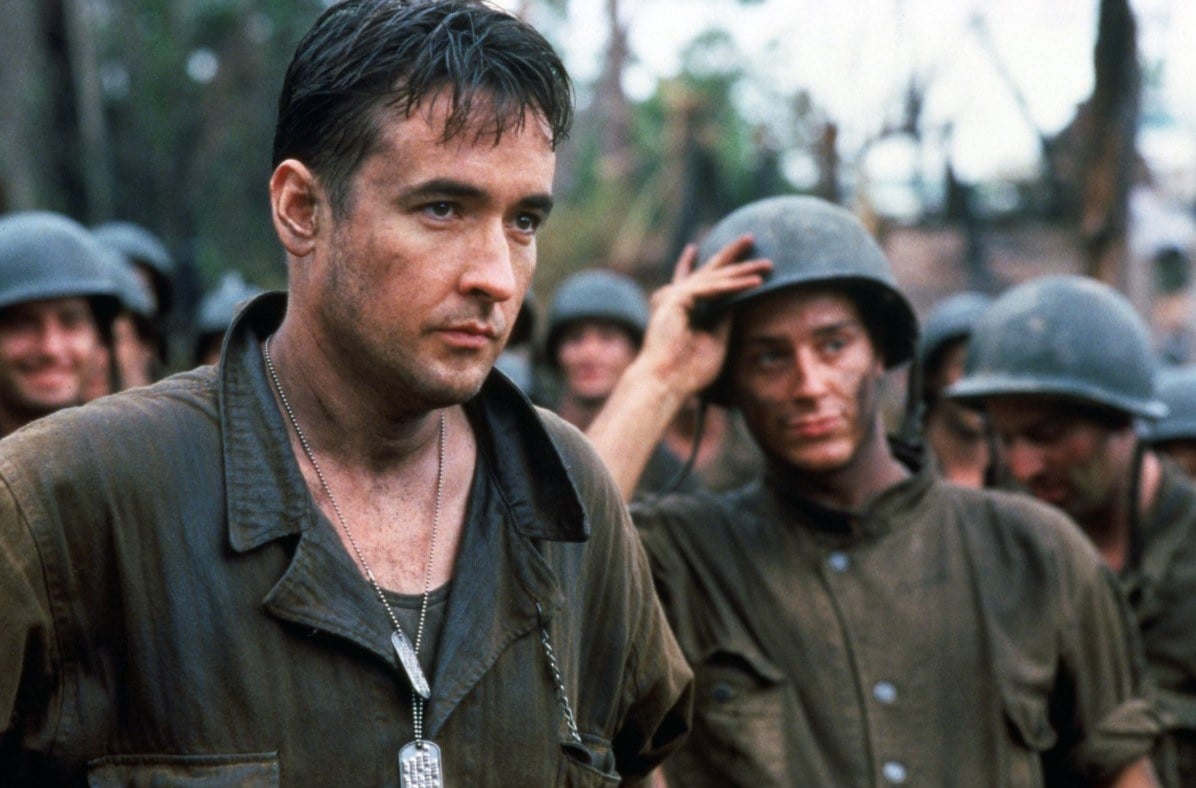
Days of Heaven is probably the most famous “magic hour” film ever made. Were you able to do that kind of work on The Thin Red Line?
Because this is a Terrence Malick film, a lot people will just assume that we sat around waiting for magic hour, but we simply didn’t have the luxury of doing that on this picture. We had a 180-page script, and after we shot all of that we went to Guadalcanal for 20 more days of unscripted improvisations. We shot relentlessly every day, in every conceivable lighting condition, from seven in the morning until it got dark at about six p.m. Yes, there are magic-hour shots in the film, but only because we had to shoot until it got dark! [Laughs.]
It’s amazing to me how often I hear cinematographers say that they think shooting good-looking day exterior movies is all about sitting around and waiting for the right light to happen, and then just pointing your camera at it and shooting ‘pretty pictures.’ Doing good work in day exterior situations means that you must be able to make great images all day long, even when the light isn’t ideal for pretty pictures. You must make choices that will allow you to take advantage of natural light in existing conditions. Even when the light is ‘bad’ it is possible to do good work by making wise choices.

The predominant day exterior lighting conditions on this film were either sunny high-contrast or soft contrast resulting from overcast conditions. Because we were shooting all day long and didn’t have the luxury of waiting for ideal light, we had to decide how to make existing light work for the scenes we were scheduled to do on a given day. It was impossible to entirely control all of the light in our shots because we were using wider-angle anamorphic lenses and constantly moving the camera. None of the traditional methods of light control, such as putting up silks, were possible, because of the terrain and the nature of the shots. Sometimes, if we were doing extended dialogue and didn’t like the way the contrast was affecting the actors’ faces, we would try to create an artificial ‘overcast’ look by staging scenes under trees or in the shadow of a hill. At other times, we would stay in the open and go with the existing high contrast, exposing the faces and letting the contrast go. There were also days when we had both overcast and high-contrast sun happening simultaneously because of low clouds moving quickly and causing severe light changes. We had some days when the light changes happened so quickly that we just shot through them. It could be blistering hot one moment, and completely dark the next — sometimes in the same shot. But that represented the reality of the situation, and we just went with it. We didn’t fight the conditions; we just tried to make them part of the story. In fact, for one Akela shot of the soldiers climbing up the hills, we waited specifically for a light change to happen. The scene starts out in heavy cloud cover, but the sun comes out and reveals these guys sneaking through the grass. That particular light change worked well for us.
The point I’m trying to make is that good daytime exterior cinematography is not comprised solely of making ‘pretty pictures’ at magic hour; it’s about being knowledgeable about your craft and being able to create interesting images in all of the various daylight conditions.
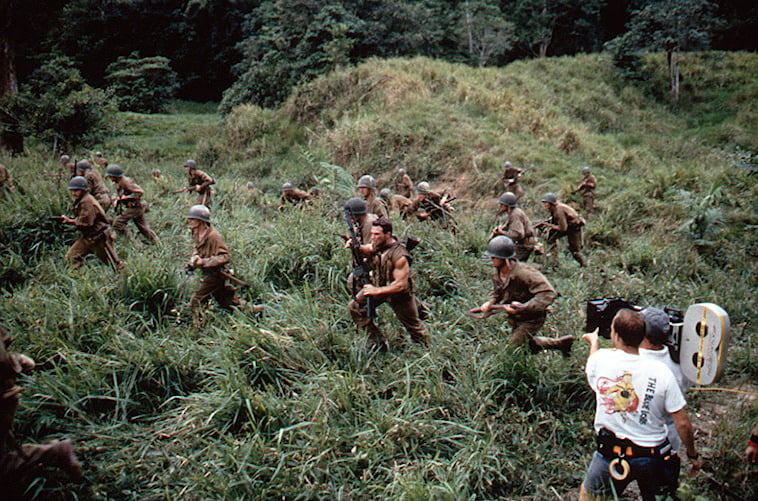
What kind of look did you go for in scenes that had to be lit?
There are some scenes at the beginning of the film that take place within a troop transport ship. We wanted to play those scenes really dark, and we used a lot of Steadicam. The ship interior set was actually built on a covered tennis court in Australia. We used every inch of that court, because we didn’t have anything resembling a stage. We basically lit the ship interior with practical fixtures that were outfitted with really hot incandescent globes. It was mostly hot toplight that created little pools of light. In areas where we didn’t have a practical fixture, we just cut a hole in the ceiling and popped a light down through it. Once again, we tried to create as much contrast as possible; the light was about three to four stops overexposed, and the shadow areas were very dark. I used more light in those scenes than I would have if it was a spherical picture; I was shooting at about T4.5 to get as much depth as possible. We were trying to really capture the claustrophobic feeling that exists within that type of ship.
There were also a few tent interiors in the picture with a nice look. There’s one scene that I really like with Sean Penn and John Reilly. We just got well back and bounced an enormous amount of light [into the tent] from a distance. Throughout the picture, we were attempting to re-create the look of the natural-light situations that we were encountering.
Which film stocks did you use?
It was primarily a day exterior shoot, so I used Kodak’s [100 ASA EXR] 5248 outside. For the lower-light situations and interiors, I used the Vision [500T] 5279. I would basically switch to the faster stock when we started to get a light reading below 2.8; I didn’t want to shoot 48 wide open on anamorphic lenses because of the lack of depth. I used the faster stock to maintain my depth of field. I find that the sharpness of the Vision stock worked well for this picture, because we were after a sense of hard reality. I still feel that the Vision stocks are slightly too contrasty, though. I prefer the older T-grain stocks like 5293, which is a really great stock.
Of course, I should point out that 90 percent of the film was shot on the 48.
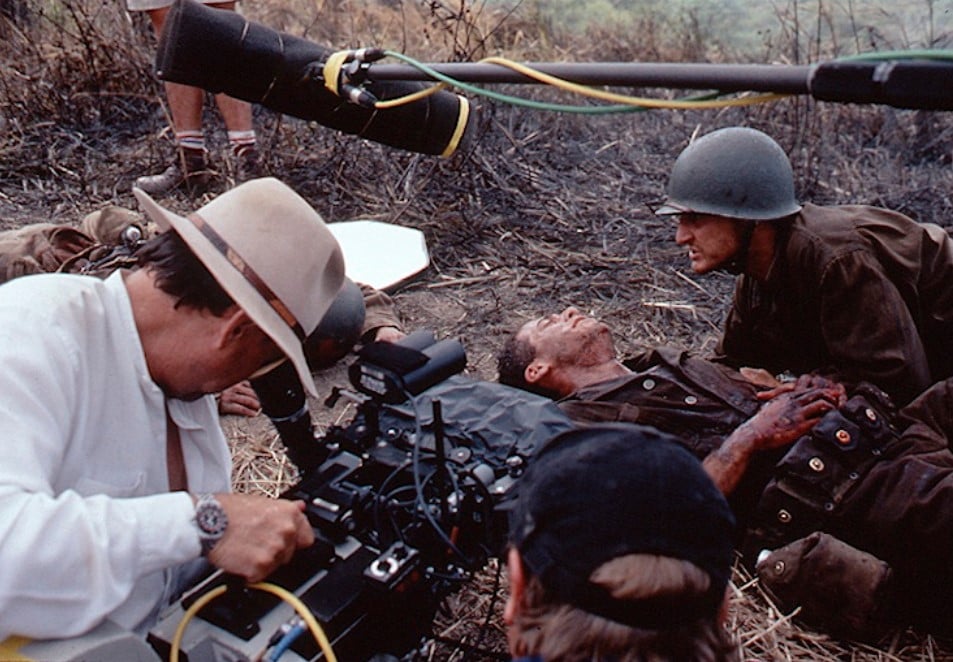
Do you have an ‘optimum’ T-stop that you prefer to work at?
I don’t normally like to work deeper than an 8, and I never work wider than 2.8 in anamorphic. I feel much more comfortable working at around 4. Shooting wider than 2.8 in anamorphic is pointless, I think, because at that stop there’s just not enough information in focus.
Did you use any filtration on this picture?
No, we shot everything clean. Every once in a while we’d throw in a grad filter if we got into some heavy, burned-out backgrounds, but we had so much camera movement that we didn’t use them a lot.
Have you applied any special lab processes?
I did a lot of testing at Technicolor before we left to go on location, and I was initially planning to do ENR prints because I really wanted to get the richest blacks possible. At the last minute before we answer-printed, though, I tested the new Kodak Vision print stock and it looked great. The blacks were very good, and I felt that the color rendition of the Vision stock was more appropriate for this picture than ENR. The ENR process is a great look, but it does desaturate some colors to a certain extent. I wanted to maintain the richness and variety of all the natural color we photographed in our tropical environments, and therefore switched to the Vision stock. Kodak was great, and we were able to get enough Vision print stock for the entire release.
While I’m on the topic, I must mention the work of color timer David Orr at Technicolor. He did a great job timing this movie on a very tight schedule. He was able to match the light in some sequences, which I was slightly nervous about. I actually was blessed on this picture with two great timers, because my dailies at Atlab in Australia were supervised by Arthur Cambridge, whom I’d first met on Wind. Arthur is the premier color timer in Australia, and I couldn’t have been in better hands.
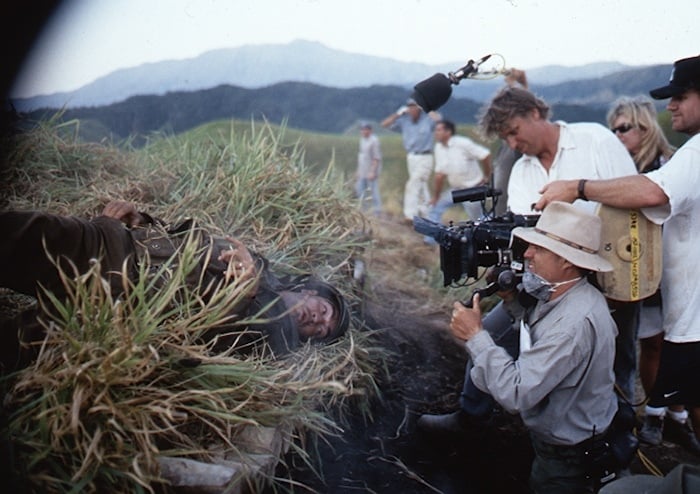
The presentation of violence in the film isn’t quite as visceral as the battle scenes in Saving Private Ryan. Was that by design?
The combat was certainly important to the story, which is about men experiencing warfare for the first time. However, the graphic and visceral aspects of that experience weren’t nearly as important to Terry as the individual soldiers’ reactions to the situation. Therefore, our presentation of that type of action isn’t as hyper-real as it is in Private Ryan. I was initially interested in taking that kind of approach, but it wasn’t Terry’s focus. Gary Capo and the second unit did a lot of the combat footage, and they did a great job, but we weren’t aiming for the same degree of intensity that Private Ryan has. This is a different kind of movie.
Were you keeping tabs on Private Ryan while you were in production?
We were shooting at the same time. My wife, Lois Burwell, was the chief makeup artist on Private Ryan. She was in Ireland and England while I was in Australia, and we would talk by phone or send e-mails back and forth. She was very excited about the work they were doing. She was designing amazing prosthetic devices and making elaborate blood rigs. She would tell me something like, ‘I can’t believe how great the dailies look. It seems so real; it’s like you’re actually watching the war. I’m really excited.’ And I would say, ‘Oh, that’s really wonderful, dear. You must be so happy.’ Of course, I was really thinking, ‘My God, no, that’s what I wanted to do on this film!’ I had been trying to get Terry to do more graphic combat right from the beginning, but he didn’t see the picture that way. After talking to my wife, I’d tell him, ‘Hey, Lois is doing all of this graphic blood stuff on Private Ryan. And he’d reply, ‘Oh, really? I don’t think I want to do anything like that.’ We were obviously interested in seeing how Private Ryan turned out, but it didn’t have any influence on what we were doing. Now, after seeing Private Ryan, I must say that I think Steven Spielberg, Janusz Kaminski, and the crew of that picture created a whole new level of expertise with that type of action and effects work. They did the best job ever of creating that kind of combat experience on film. Ryan is a fantastic film.
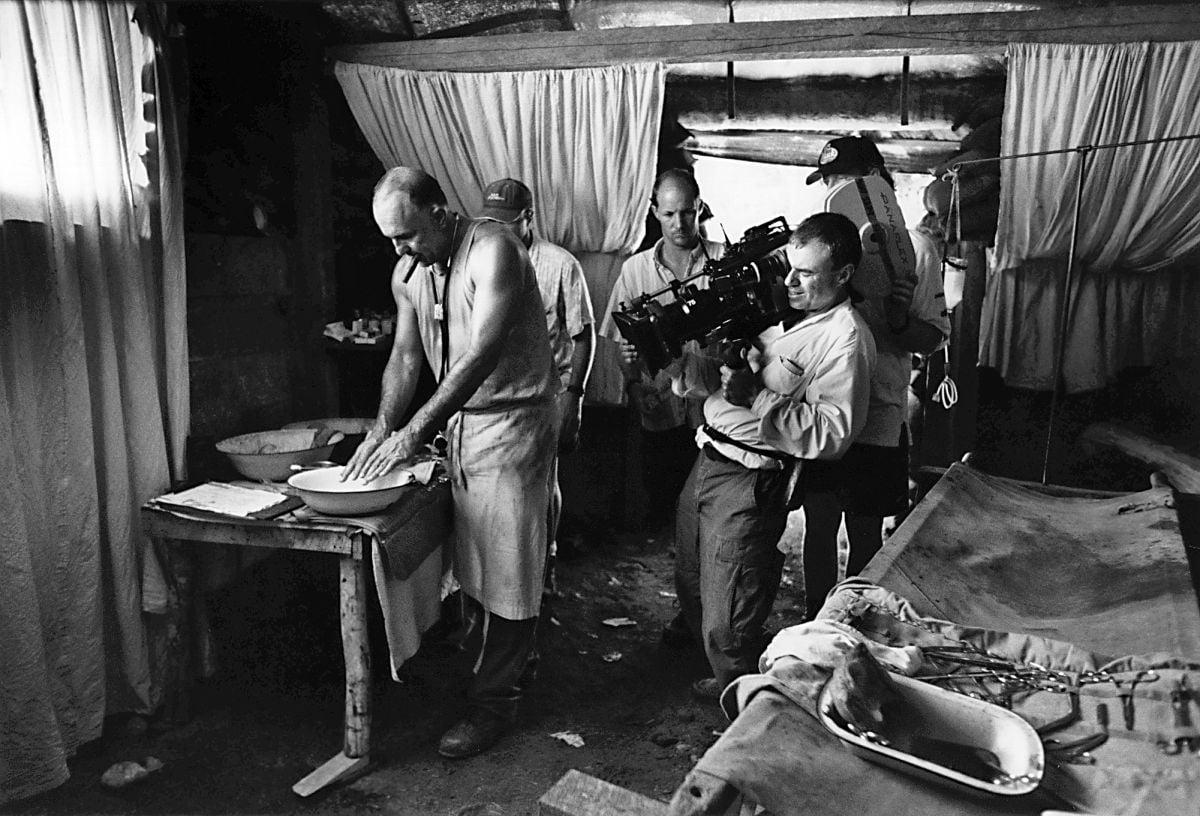
Did you use multiple cameras for any of the battle footage?
We didn’t do that as much as I had on Braveheart. There was only one day when we had a combined first and second unit and we shot with four cameras. The majority of the time, the first and second units shot with two cameras. I was almost reluctant to do this movie because of Braveheart; I thought that the last thing I should be doing at this point in my career was another day exterior battlefield movie [laughs], but I was drawn to the material and the idea of working with Terry. I tried not to think about Braveheart while we were shooting, and this movie didn’t have that kind of scale. It didn’t involve the same numbers of people, and we didn’t put as much emphasis on the fighting itself. The battles weren’t as grand in scope.
How extensive were the practical effects in those sequences?
Again, it wasn’t quite as involved as the work in Private Ryan. We had a great special effects team, headed by an Australian named Brian Cox; they did a terrific job, but [the combat] wasn’t the most important aspect of the picture. We had several mortar and artillery barrages that were fairly big, as well as nighttime pyro effects for a bombing raid on the airfield. All of our lighting in that sequence came from the explosions themselves; we played the soldiers in silhouette as the ‘bombs’ went off. We did some tests with the effects guys to determine how hot their explosions were going to be, and then exposed at around T4.

What kind of footage were you after when you went back to Guadalcanal?
One aspect of Guadalcanal that wasn’t in the book, but which interested Terry very much, was the ethnographic aspect of the island. The story of the Melanesian people who lived there during the war is really interesting. They had existed for centuries in this very peaceful and tropical place when they were suddenly invaded by all of this large-scale violence. Even today, it’s a fairly isolated environment.
When we went back to the island, we wanted to find some native people to put in the picture. One of the lead characters, Witt [played by Jim Caviezel], spends time in a Melanesian village, and that’s where the picture opens. Terry wanted to introduce this idea early on, and he wanted to present these people in their traditional lifestyle, as it had existed back in the 1940s. We did a lot of research, and we discovered that this culture no longer existed in the areas of Guadalcanal that were logistically accessible to us. We, therefore, put together a special third unit to find a village and shoot anthropological footage. The unit was headed up by Reuben Aaronson, who had done a lot of National Geographic shoots. He and his team went to this traditional village on the south side of the island, and stayed there for a couple of weeks.
How did the Melanesians react to having a camera crew in their midst?
Sometimes it worked out, and sometimes it didn’t, but that’s the nature of ethnographic work. Reuben had an anthropologist with him, Christine Jourdan, who has made a career out of studying the people of the Solomon Islands. She really knew the people, and how to blend in with them. They shot footage of these people existing with no trace of modernity around them, and some of it’s in the picture. Reuben had never shot 35mm, and he suddenly found himself working with a Panaflex and anamorphic lenses. He did a great job, though. When the first unit went in later, we re-created a portion of the village in an area that was accessible to us, and got some of the locals to come in and interact with our actors. They spent a few days getting to know each other, and then we improvised a few sequences. The people were very natural, because all they had to do was be themselves. We used a very reduced unit to make them feel more comfortable.
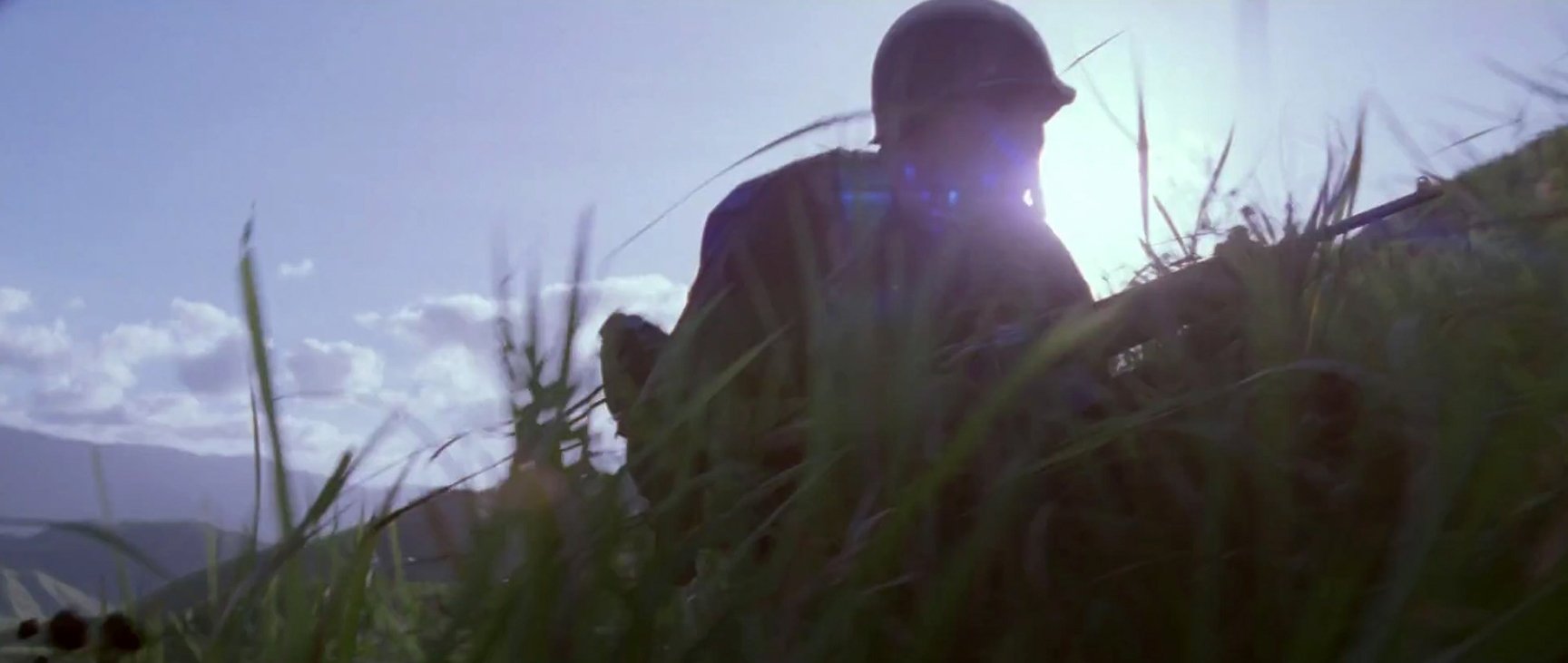
What else did you shoot on Guadalcanal?
We were able to get some shots that established the geographic continuity between Savo Island, the beach, the palm trees and the hills. Savo Island was the site of several horrendous naval battles, and the huge coconut groves on Guadalcanal really had the signature look of the South Pacific. In addition, the hills on the island are within a mile or two of the beach, but those areas didn’t exist in Australia. By shooting on Guadalcanal itself, we were able to establish that connection.
How did that experience affect you personally?
Going to Guadalcanal was the best thing we could have done to get a sense of the real circumstances of the war. In fact, there are still a lot of artifacts from the war lying around. The locals showed us pieces from their collections, which included weapons, uniforms, helmets, and so on. We were constantly finding remnants of the battle at some of our locations. One of the assistant directors even tripped over a spent artillery shell that was buried in the ground.
Being there also helped to give us a better appreciation for what everyone there must have gone through. The jungle on the island is an extremely uncomfortable environment — it’s very hot and humid. We visited the sites of many of the battles described in the book, and they were pretty amazing. You just cannot imagine how horrible it must have been. The idea of these men living out there for months at a time in such dangerous and brutal combat situations seems just incredible to me. I think we all came away with a real sense of the sacrifice that was made by everyone who participated in the war. Hopefully, our film works as an illustration of that.
As much as any film I’ve ever worked on, this picture was about an idea. I believe that what Terry wanted the film to be about, most of all, was that the real enemy in war is the war itself. War, and not necessarily one side or the other, is the great evil. It isn’t often that one gets to work on films of this nature, and I’m grateful that I had the opportunity to participate in making it.
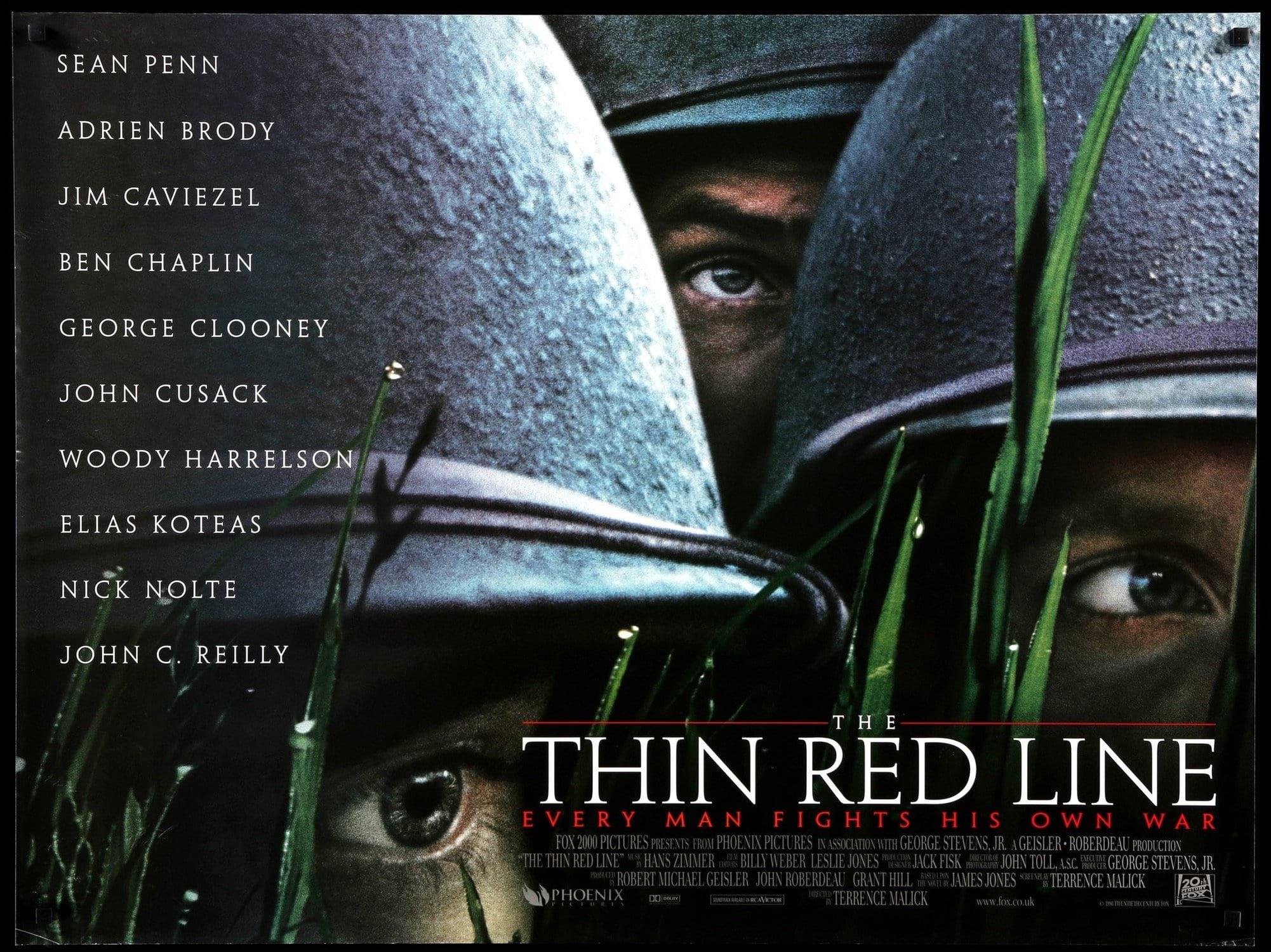
Toll earned an Academy Award nomination and the ASC Award for his expert camerawork. He was honored with the ASC Lifetime Achievement Award in 2016.






